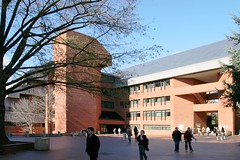Hunter Rawlings, the president of the Association of American Universities, the consortium of the large research universities in the country, recently wrote a thoughtful essay challenging various beliefs about the key purposes of universities.
As more and more commentators are noting, assessing the value of a university based only on lifetime earnings (or even more radically, the income of the first job post graduation) misses many of the components of the experience.
However, Rawlings makes another point — thinking of university degrees as something to purchase, as a consumer product is also a dangerous misunderstanding. Students maximize the value of their higher education by maximizing the effectiveness of their studying. The more the students give of their own time, the higher the value of the purchased experience.
As we are discovering in the Designing the Future(s) activities, much learning of students takes place out of the classroom, in on-the-job experiences connected to their educational programs and in research-based work. The vast majority of these activities are situations in which the students are actively teaching themselves. That is, the students are investing their own time to achieve the benefits of the education.
In some sense, students are not consumers purchasing a good, they are producers of their own education guided by faculty mentors. They are not buying teaching; they are subscribing to a set of experiences that allows them to discover their talents and interests.
Rather than thinking of acquiring higher education as the purchase of shares of stock, in which a chief purpose is a passive return on investment, maybe it’s better to think of higher education as a fitness center where the chief purpose of the membership is better health status. The membership fee gives one access to exercise facilities and machines, but the health status benefits arise only if the member optimizes their use. The “return on investment” is fully in the hands of the member.
Good health through exercise can be achieved in many different ways. Some people thrive in group activities, using others to heighten motivation. Some emphasize cardiovascular health through aerobic exercise. Some lift weights. Choosing the right fitness center, like choosing the right university, is a matter of matching aspirations, self-knowledge, and the assets of the organization. But, just like a fitness center membership, students get their “return on investment” when they take advantage actively of all the resources of the organization. When students take charge of their education, direct it, invest deeply through their own time, only then do they gain the benefits of the higher education institution.
When students come to realize that they are the producers of their education, not consumers, then, higher education productivity is maximized.

This is very well put and really does emphasize the collaborative educational effort between faculty and students. Thanks for the new analogy.
Or in another vein, there is an old medical school saying that one must ” see one, do one, then teach one” because only by teaching it to others do we really learn.
To quote the great UCLA bball coach ” The harder i work the luckier i get!” ( John Wooden), Sorta like this. ACTIVE learners sorta…. LEARN MORE. Nice post as usual.
Right on target. One of your most insightful posts yet…
Since I find the consumer model and discourse of education so destructive on so many levels, I initially approached this post with skepticism. “Producer” sounds too much a part of the Consumer discourse for my liking.
However, I find the gym analogy useful. It gets closer to the Design/ Designer analogy Randy has been using. And both of those, for me, also connote “artist” and “disciple” –not to mention “apprentice.” And those analogies certainly do inform my understanding of education.
It’s the same with technology. You can buy it, but it’s useful only after you have invested in time and money (the old rule of thumb was three times the original cost) to learn to use it and improve it.